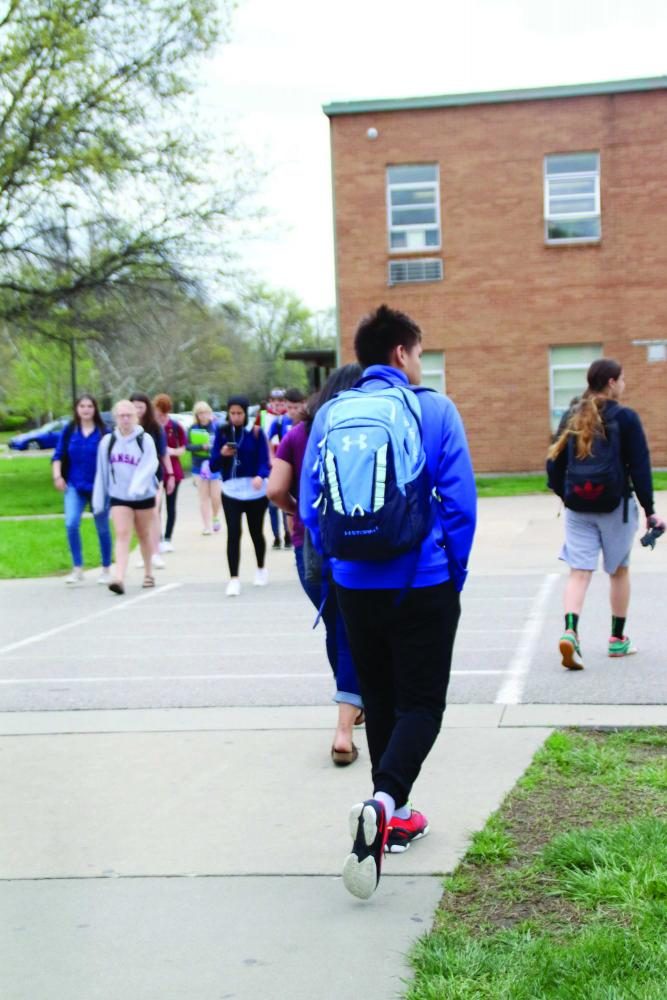Bond Issue Seeks School Makeover
Mail-in ballots results will decide building’s future
insecure — Students head to and from the annex during passing period. The annex’s open entrances make it difficult to secure for students.
April 20, 2017
Imagine it is after your graduation. You return to Lawrence High and enter an unrecognizable building. Modern, accessible and expanded with upgraded technology and facilities. With the proposed school bond issue currently before voters this could become Lawrence High’s reality.
The bond issue was created to address the concerns expressed in public polling, including classroom sizes and modern upgrades. A total budget of $87 million would be spent to upgrade all the high schools and middle schools in Lawrence. Of that budget, $50.8 million would be spent on Lawrence High alone.
Registered voters received mail-in ballots on April 12, which need to be returned by May 2 to be counted.
The passing of the bond would impose an annual $55 tax increase to owners of a $200,000 home.
“There are people that own millions of dollars of property so this will cost them thousands or tens of thousands of dollars, and they’ve been supportive of it,” assistant principal and head of facilities Mike Norris said. “I’m hopeful.”
Many students and faculty members wish to see the building upgraded and renovated to increase learning opportunities and space. As technology increases and plans such as 1-to-1 become tangible, a building that is adaptable is necessary.
“I think LHS and the district need to improve WiFi infrastructure and maintenance if we want all classrooms to be ‘blended’ and if all students are using MacBooks,” French teacher Megan Hurt said. “The annex has WiFi instability. We need more and better-placed restrooms in the annex, as well as an improvement of the organization and flow of hallways to classrooms.”
The bond would go toward creating a safe and secure campus, enlarging classrooms and corridors, developing student collaboration spaces and courtyard, creating a modern library media center, connecting the annex to the main building; and renovating the gyms, natatorium, weight rooms, locker rooms, fine art spaces, career and technical education areas, and restrooms.
Students have many concerns about the current standards of the facilities, including unsecured entrances and small spaces.
“I knew that I would be voting yes for the bond issue because of my four years at Lawrence High,” senior Bridget Smith said. “The building is not suitable for its current use. It is too small for its current student population. It is difficult to navigate and is unsafe for students.”
Overall upgrades to the infrastructure and aging building systems as well as site improvements are also proposed.
“Connecting the classrooms to the main building is critical, we simply do not have the resources to continue to send over 200 students outside our main building and across the campus throughout the day in a manner that is secure,” said Norine Spears, organizer for a vote yes canvassing campaign and member of the LHS Site Council. “Gutting the annex and creating intentional classrooms is a huge improvement, but also providing adequately-sized, inviting classrooms in the main building with collaborative areas for both our teachers and students will transform our school.”
In a public survey conducted by Patron Insight, class sizes received the second lowest score and is the basis of many concerns.
“What the building size does…is it traps us in a very traditional teaching and learning type of model,” Norris said. “Because you can make a small room work if you’ve got all your desks in rows. But as soon as you start trying to spread out, as soon as you start trying to do more of an inquiry-based learning or project-based learning or something like that, we hit the walls very quick in some of our rooms.”
When the 2013 bond issue was passed, Lawrence High received a few updates, including a new black box theater and expanded cafeteria, but the primary focus was the elementary schools. During this time, the Lawrence High Site Council, a group of parents the help advise, toured the school and recognized many problems.
“The LHS facilities have suffered from deferred maintenance, the creation of makeshift classrooms, and the lack of a master plan for its campus for a very long time, and it needs to be addressed,” Spears said. “Our teachers and students work hard and make our community proud every day, and it’s time we give them a facility that supports and enhances your efforts, rather than spaces that create educational challenges. Lawrence is a city that supports public education, and we should have two high school facilities that they can be proud of.”
The Site Council contacted some architectural students from the University of Kansas and had them propose renovations and upgrades. This initiated the conversation about Lawrence High renovation and expansion.
“It was very conceptual and it is what got the ball rolling,” Norris said. “And then a lot of people started expressing a lot of concerns and interests in the renovation of Lawrence High and the comparisons between the two schools and stuff like that. That made it a school board issue, so the school board wanted to study it and then they got some architects in here and there were some studies that were done based on classroom size and some other things that were done. That’s what led to a proposal, which led to a bond.”
Since the bond issue hasn’t passed and the changes are hypothetical, many of the building and fundamental plans are not definitive.
“Some of that is still in the design phase, exactly figuring out how that sequencing would work,” Norris said. “What would happen is part of this year of planning, designing would also be a year of planning the stages and how to move people around. Obviously if we are gutting the annex, those teachers are going to have to get moved right away, those sorts of things.”
Construction wouldn’t begin until 2018.
“So we wouldn’t be looking at actually breaking ground, as they call it, until June 2018,” Norris said. “And then in June of 2018, the projects, to my understanding, that they would start first are the annex. Gutting the annex and building the connection between the main building and the annex. And there may be some other stuff, too. But, the reason for that is getting that stuff done then provides classroom spaces. Especially in that connection, that bridge between, that gives you places you can start rotating teachers through those areas and stuff like that.”
The bond has received concerns from not only students and faculty, but members of the community. Canvassing campaigns have developed to promote the bond issue and rally support.
“As a citizen in a democracy, being involved in local issues is something I feel very strongly about, and this campaign would allow students to talk first hand about their experiences and reasons they endorse the bond,” Spears said. “It would also be a way for current students to support the next generation and leave LHS a better place than what they inherited.”
Generally, she said members of the community seem hopeful and encouraging of the bond issue.
“As I talk about the bond throughout town, I run into both support and opposition but mainly support,” Spears said.
If approved, Norris said he looks forward to how the dollars would improve student flexibility by enlarging classrooms and providing enough space for people to function efficiently.
“The thing is 90 percent of learning at school occurs in the classroom and so at the end of the day, I think it’s about that,” Norris said.















